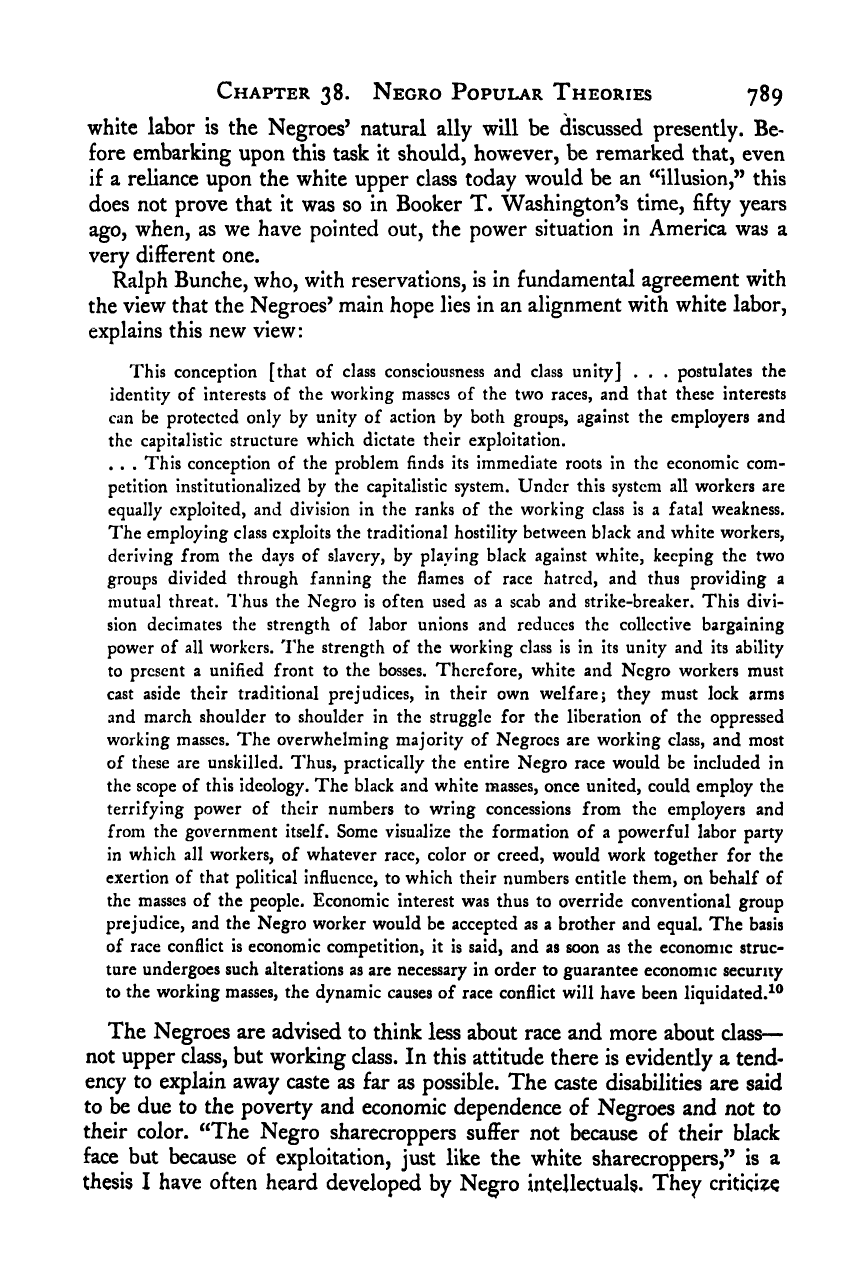Note: Gunnar Myrdal died in 1987, less than 70 years ago. Therefore, this work is protected by copyright, restricting your legal rights to reproduce it. However, you are welcome to view it on screen, as you do now. Read more about copyright.
Full resolution (TIFF) - On this page / på denna sida - IX. Leadership and Concerted Action - 38. Negro Popular Theories - 5. The Doctrine of Labor Solidarity

<< prev. page << föreg. sida << >> nästa sida >> next page >>
Below is the raw OCR text
from the above scanned image.
Do you see an error? Proofread the page now!
Här nedan syns maskintolkade texten från faksimilbilden ovan.
Ser du något fel? Korrekturläs sidan nu!
This page has never been proofread. / Denna sida har aldrig korrekturlästs.
Chapter 38. Negro Popular Theories 789
white labor is the Negroes’ natural ally will be discussed presently. Be-
fore embarking upon this task it should, how’ever, be remarked that, even
if a reliance upon the white upper class today would be an “illusion,” this
does not prove that it was so in Booker T. Washington’s time, fifty years
ago, when, as we have pointed out, the power situation in America was a
very different one.
Ralph Bunche, who, with reservations, is in fundamental agreement with
the view that the Negroes’ main hope lies in an alignment with white labor,
explains this new view:
This conception [that of class consciousness and class unity] . . .
postulates the
identity of interests of the working masses of the two races, and that these interests
can be protected only by unity of action by both groups, against the employers and
the capitalistic structure which dictate their exploitation.
. . . This conception of the problem finds its immediate roots in the economic com-
petition institutionalized by the capitalistic system. Under this system all workers are
equally exploited, and division in the ranks of the working class is a fatal weakness.
The employing class exploits the traditional hostility between black and white workers,
deriving from the days of slavery, by playing black against white, keeping the two
groups divided through fanning the flames of race hatred, and thus providing a
mutual threat. I’hus the Negro is often used as a scab and strike-breaker. This divi-
sion decimates the strength of labor unions and reduces the collective bargaining
power of all workers. The strength of the working class is in its unity and its ability
to present a unified front to the bosses. Therefore, white and Negro workers must
cast aside their traditional prejudices, in their own welfare; they must lock arms
and march shoulder to shoulder in the struggle for the liberation of the oppressed
working masses. The overwhelming majority of Negroes are working class, and most
of these are unskilled. Thus, practically the entire Negro race would be included in
the scope of this ideology. The black and white masses, once united, could employ the
terrifying power of their numbers to wring concessions from the employers and
from the government itself. Some visualize the formation of a powerful labor party
in which all workers, of whatever race, color or creed, would work together for the
exertion of that political influence, to which their numbers entitle them, on behalf of
the masses of the people. Economic interest was thus to override conventional group
prejudice, and the Negro worker would be accepted as a brother and equal. The basis
of race conflict is economic competition, it is said, and as soon as the economic struc-
ture undergoes such alterations as are necessary in order to guarantee economic security
to the working masses, the dynamic causes of race conflict will have been liquidated.^®
The Negroes are advised to think less about race and more about class
—
not upper class, but working class. In this attitude there is evidently a tend-
ency to explain away caste as far as possible. The caste disabilities are said
to be due to the poverty and economic dependence of Negroes and not to
their color. “The Negro sharecroppers suffer not because of their black
face bat because of exploitation, just like the white sharecroppers,” is a
thesis I have often heard developed by Negro intellectuals. They criticize
<< prev. page << föreg. sida << >> nästa sida >> next page >>